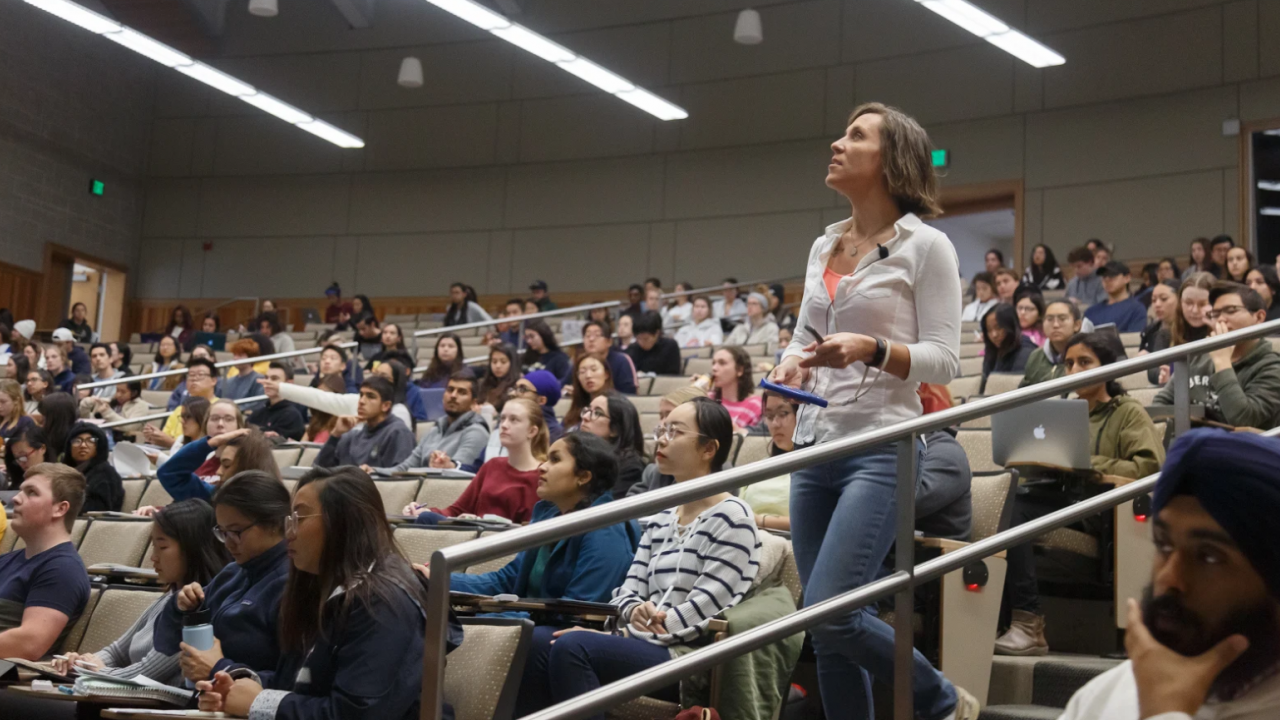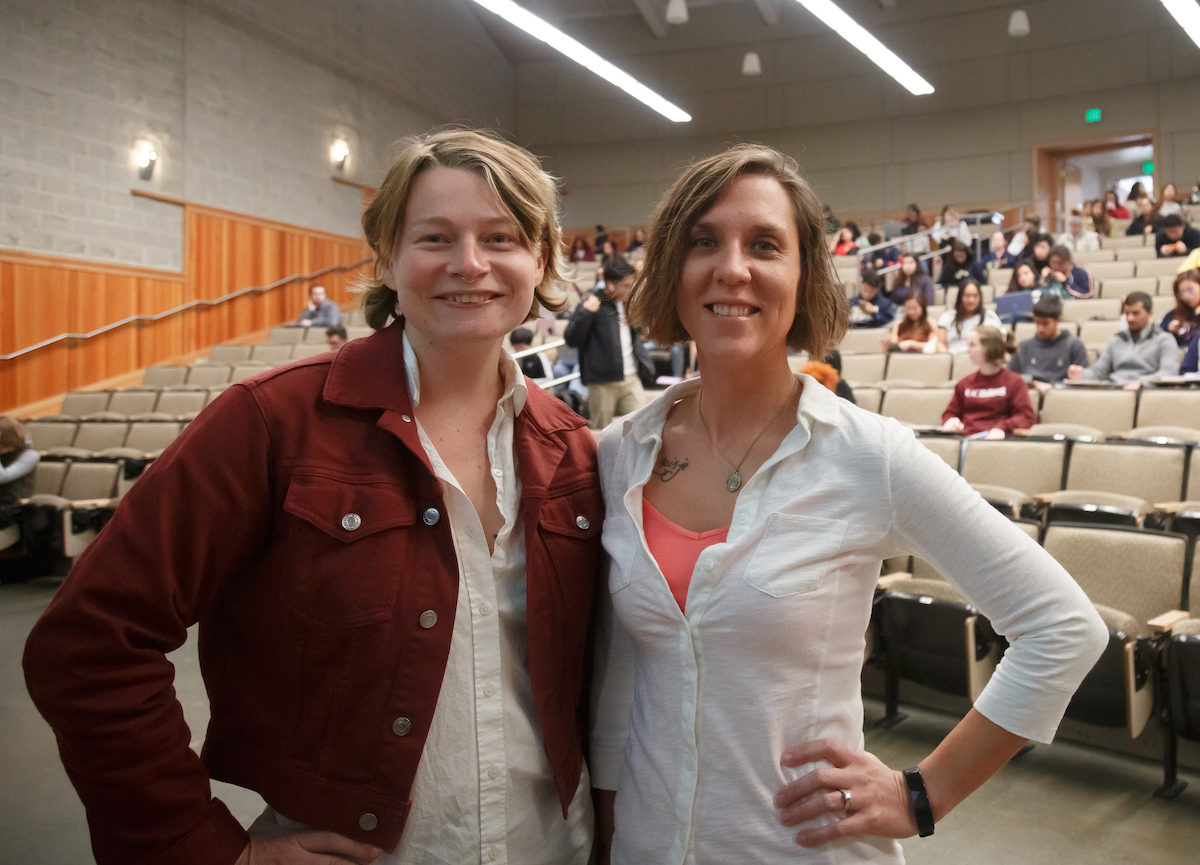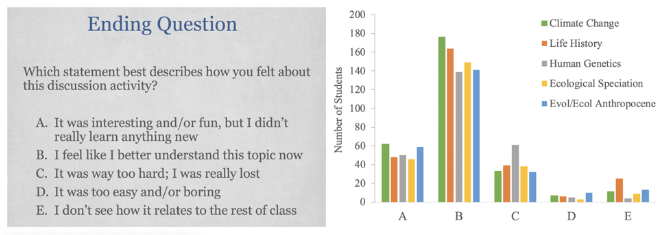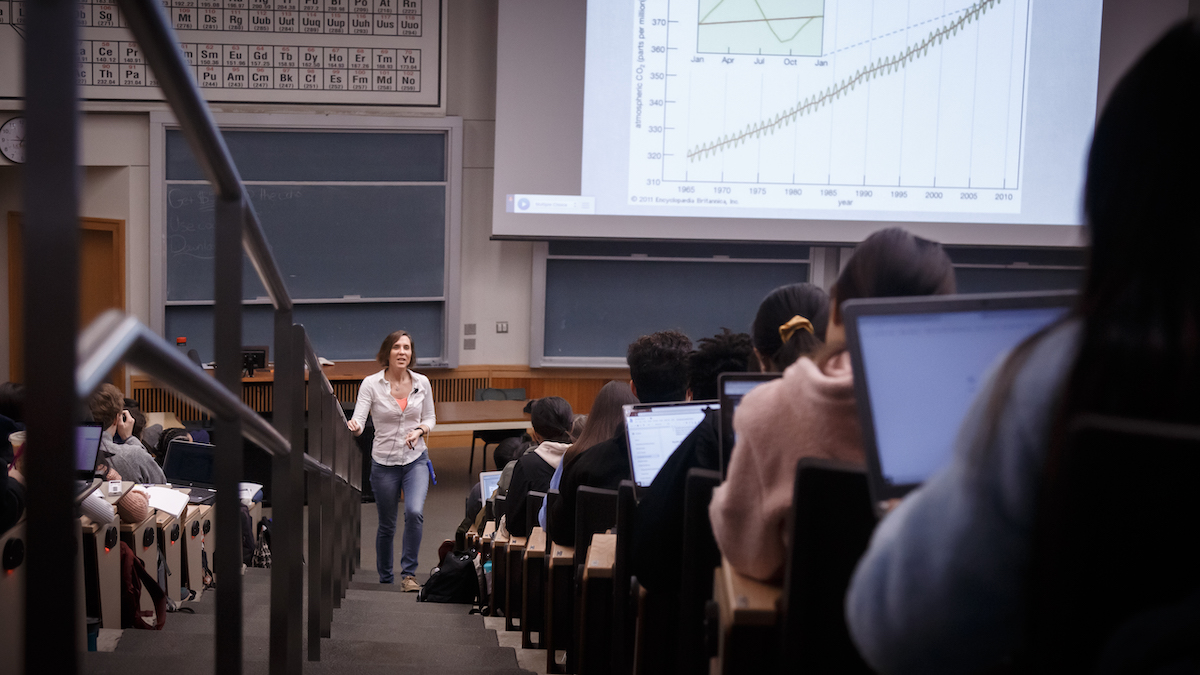
Bringing Active Learning into High Enrollment Classrooms: Gathering and Reflecting on Feedback
By Laci Gerhart-Barley, Assistant Professor of Teaching Evolution and Ecology and Amelia Munson PhD Candidate, Animal Behavior Grad Group
I’m the poster child for a professor who should *not* be interested in active learning. I’m both incredibly Type A and super extroverted, which means I love talking, I love being the center of attention, I love being in control, and I hate change. Active learning is the opposite of all those things. It requires you -- the instructor -- to let go of being the center of the students’ attention, to silence yourself so they can hear their own voices, to relinquish some control of the pace and focus of the class period, and to accept a certain amount of uncertainty in how the activity will go.
When I transitioned from small fully-flipped classes to large-enrollment lecture courses, I wondered - how do I get that same level of interaction with hundreds of students? How do I even know if they’re struggling before the exam? To work on this question, I participated in CEE’s inaugural CREATE program, for which I developed active learning discussion sessions and low-stakes formative assessment homework assignments for the Fall 2018 quarter of Biosciences 2B. To support the process, I hired Animal Behavior PhD student and experienced BIS 2B TA, Amelia Munson.
Amelia: "As a TA, I am often a more approachable figure than the instructor and meeting with students in the BIS 2B had given me an understanding of what was working, and what wasn’t, for students. I have always found teaching to be extremely fulfilling and wanted to expand my skillset of techniques and Laci’s excitement was contagious. Perhaps we were a little naive when we began this process but this naivete was probably beneficial as we embarked on a process that would require lots of iterations and serious rethinking all along the way."

The Reflection Process: Try, Try Again (and then one more time)
Discussion activities focused on the active research programs of UCD faculty, and replaced traditional lecture-style content. I already used the discussion sessions as a series of case-studies, so this transition did not raise many content coverage issues. In a few cases, though, the reorganization did require reducing or removing some topics; generally, I chose to cut content that was covered more robustly and more actively in the laboratory exercises. Each discussion consisted of several modules each containing multiple slides of data figures and multiple discussion questions guiding the students through the studies and results.
If that sounds too ambitious, it was. Several times we crashed the classroom wifi as students downloaded the Canvas content, meaning my iClicker Cloud stopped recording and students’ REEF accounts failed. Nearly every activity was too long. They figured out I would eventually explain the conclusions myself and became increasingly disengaged. Amelia and I kept a reflection journal and our entries are riddled with problems - scaffold the activities more, shorten them, focus harder on key points. One journal entry is a single frustrated scrawl: “How to solve the lethargy?!”
Despite these frustrations, the student feedback was suspiciously positive (Figure 1) compared to their behavior in class and their performance on discussion-related exam questions.

Figure 1: Student feedback question for each discussion (left), and student responses split by discussion topic (right).
Amelia: "Many of even our most engaged students admitted they were lost, and yet they almost universally seemed hopeful and trusting in Laci and the process. I got the feeling that they wanted things to work out because they liked Laci and wanted her to be happy. While that was obviously not our goal, I think it was this dynamic that was particularly helpful during the process. We continued to talk to students and watch them in discussion, which was far more valuable feedback than the clicker question. Respecting the experiences of the students and working to meet them where they are instead of forcing our idea of the activity on them is perhaps the most valuable thing I took from that first quarter."
For Winter Quarter 2019, I shortened the activities immensely, but kept their overall structure. Honestly, it went worse than the first time. The students were overwhelmed, frustrated, and disengaged. Almost immediately, I felt they sat back and waited for me to show them the ‘answers’. I very seriously considered scrapping it all and going back to the lecture-style content I used before CREATE.

Instead of giving up, I sought additional feedback from a research lab in my department, which frequently supplies TAs and instructors to BIS 2B. They were extremely honest in their constructive criticisms, which led to me completely restructure the activities:
- We consider one question at a time.
- We talk through the options together before the students make a prediction
- We analyze figures together, moving at one pace, instead of working on their own.
This structure feels less ‘active’ to me, but it keeps the students engaged and it helped me shorten the discussions and focus on the questions that truly mattered.
Most notably, the students finally seem to be enjoying the discussions. The modules deal with real data in systems that are not fully ‘worked out’ and so often the results are unexpected. Every discussion has at least one component where the students must predict the outcome of a study and the outcome they pick makes total logical sense and is not what the study actually found.This aspect is the most frustrating to students, and the most like real science. Usually, when I show the results, I get a lot of groans and I can feel the anxiety in the room rise.
"n the discussion last week though, we had a breakthrough! When I showed the results of their clicker vote on the prediction, they were evenly split between the options - and the whole room busted up laughing.
Finally, they found the difficulty and complexity amusing instead of frustrating and debilitating. I hope this continues, and I hope it means that the students are finding a comfort with the uncertainty required in the learning process, just like I am.
Postlude: Third time is a charm
I find that it takes about three rounds with actual students in a classroom setting before an activity ‘works’ as intended. By the third round, I have a sense of which parts of the activity will be the hardest for students, and (more importantly) why these parts are hard, which helps me help them work past the difficult sections. In addition, I’ve continued to ask for student feedback on the discussions, this time through an open-ended student evaluation question, which lets them provide anonymous feedback and more detailed responses than the clicker question allowed. With their feedback, I hope to keep improving the discussion activities so they are challenging in an exciting way, not an overwhelming one.
Request a Reflective Teaching Journal
As you think about ways to reflect on how to support First Generation students, let CEE support your process with a free journal. Complete the following form and we will send you one via campus mail.
